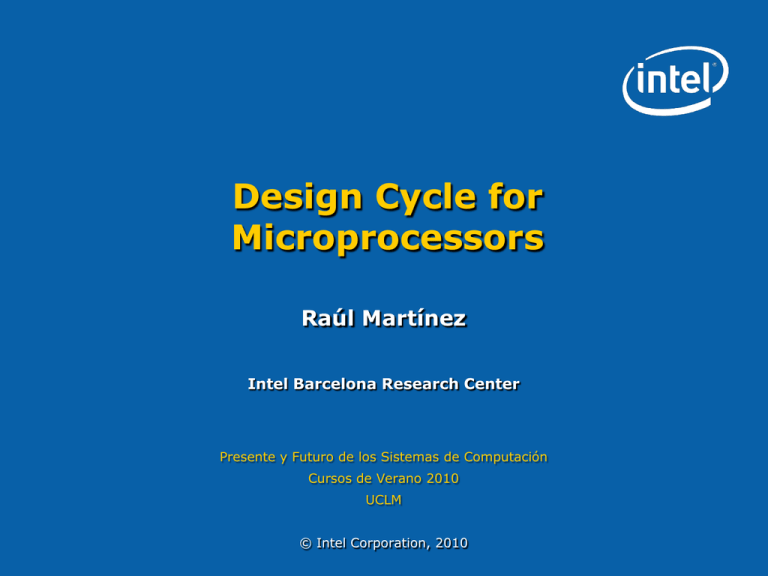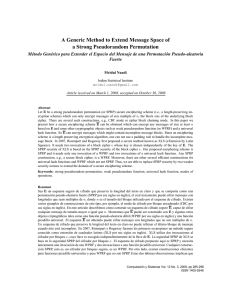Presentación
Anuncio

Design Cycle for Microprocessors Raúl Martínez Intel Barcelona Research Center Presente y Futuro de los Sistemas de Computación Cursos de Verano 2010 UCLM © Intel Corporation, 2010 Agenda • Introduction • Design plan • Architecture design • Microarchitecture design • Logic design • Physical design • Silicon ramp • Design Types and Intel Tick-Tock model • Conclusions 2 Presente y Futuro de los Sistemas de Computación Introduction Design plan Architecture Design specification Behavioral design Microarchitecture Logic Validation Circuits Layout Physical design Silicon debug Silicon ramp 3 Presente y Futuro de los Sistemas de Computación Production Design plan Architecture Microarchitecture Physical design Logic Circuits Silicon ramp Behavioral Design design specification Design plan Silicon debug 4 Layout Production • Design plan must consider the entire design flow from start to finish and answer several important questions: – For which product and market segment is going to be used the processor? – Which are the requirements in terms of performance, power, and cost? – What previous design (if any) will be used as a starting point and how much will be reused? – How long will the design take and how many designers are needed? Presente y Futuro de los Sistemas de Computación Design plan Market Server Desktop Mobile Embedded Product Priorities High-end server Performance, reliability, and multiprocessing Farm/Blade server Performance, reliability, and multiprocessing within power limit High-end desktop Performance Mainstream desktop Balanced performance and cost Value desktop Lowest cost at required performance Mobile desktop replacement Performance within power limits Mobile battery optimized Power and performance Mobile handheld Ultralow power Consumer electronics and appliances Lowest cost at required performance Microprocessor Products and Market segments 5 Presente y Futuro de los Sistemas de Computación Behavioral Design design specification Architecture design Design plan Architecture Microarchitecture Logic • A processor architecture is all the features of a processor that are visible to the programmer (Operating System and Applications). Applications Physical design Circuits Silicon ramp OS Silicon debug 6 Layout Processor Production Presente y Futuro de los Sistemas de Computación Silicon ramp Physical design Behavioral Design design specification Architecture design 7 Design plan Architecture Microarchitecture Logic Circuits Layout Silicon debug • A processor architecture is all the features of a processor that are visible to the programmer (Operating System and Applications). Design decision Possible choices Operand types for computation Pure register, register/memory, pure memory Data format supported Integer, floating point, SIMD, … Data Address Modes Absolute, register indirect, displacement, indexed, … Virtual memory implementation Virtual address size, allowed page sizes, page properties Instruction encoding Fixed or variable, number registers, size of immediates, … Production Presente y Futuro de los Sistemas de Computación Architecture design Instruction Set Architecture (ISA) Category CISC Complex Instruction Set Computers Complex but compact instructions RISC Reduce Instruction Set Computers Simple instructions VLIW Very Long Instruction Word An instruction is a set of operations grouped together by the compiler Category CISC RISC VLIW 8 Architecture Processor Manufacturer VAX MicroVax 78032 DEC X86 Pentium 4, Athlon XP Intel, AMD SPARC UltraSPARC IV Sun PA-RISC PA 8800 Hewlett Packard PowerPC PPC 970 (G5) IBM EPIC Itanium 2 Intel Presente y Futuro de los Sistemas de Computación Design plan Architecture Microarchitecture Physical design Logic Circuits Silicon ramp Behavioral Design design specification Microarchitecture design Silicon debug 9 • The architecture defines the instructions the processor can execute. • The microarchitecture define determines the way in which those instructions are executed. • Microarchitecture decisions have the greatest impact on the processor's performance, power, and area (cost). Layout Production Presente y Futuro de los Sistemas de Computación Microarchitecture design • Microarchitecture changes are not visible to the programmer and can improve performance without software changes. • Because microarchitectural changes maintain software compatibility, processor microarchitecture have changed much more quickly than architectures. • Today's higher integration capacity allows more complex techniques to be implemented. Applications OS ISA Microarchitecture 10 Presente y Futuro de los Sistemas de Computación Microarchitecture design The microarchitecture defines the different functional units on the processor as well as the interactions and division of work between them. 11 Presente y Futuro de los Sistemas de Computación Microarchitecture design • Designing a processor microarchitecture involves trade-offs of IPC, frequency, die area, power, and design complexity. – Number of stages of the pipeline. – Instruction issue width. 12 Presente y Futuro de los Sistemas de Computación Microarchitecture design • Designing a processor microarchitecture involves trade-offs of IPC, frequency, die area, power, and design complexity. – Number of stages of the pipeline. – Instruction issue width. – Methods to resolve control dependencies. – Methods to resolve data dependencies. – Memory hierarchy. – In-order / out-of-order execution – Multi threading – Branch prediction – Number and type of functional units 13 Presente y Futuro de los Sistemas de Computación Design plan Architecture Microarchitecture Physical design Logic Circuits Silicon ramp Behavioral Design design specification Logic design Silicon debug 14 Layout • Typically, microarchitecture design produces diagrams showing the interaction of the different units of the processor and a written specification describing the different algorithms. • The logical design goal is to obtain a much more detailed and formal description of the logical behavior of all the units and the signals that communicates them. • The microarchitectural specification is turned into a logical model that can be tested for correctness. Production Presente y Futuro de los Sistemas de Computación Logic design • In order to obtain this model, a Hardware Description Language (HDL) is used to describe the processor. • HDL languages as Verilog and VHDL, are high-level programming languages created specifically to describe and simulate hardware designs. HDL levels of abstraction 15 Includes all the important events but not specifies their exact timing. Register transfer level (RTL) Models the processor clock and the events/signals that happen at each cycle. An RTL model should be an accurate simulation of the state of the processor at each cycle boundary. Structural level Shows the detailed logic gates to be used within each cycle. Presente y Futuro de los Sistemas de Computación Abstraction Detail Behavioral level Design plan Architecture Microarchitecture Physical design Logic Circuits Silicon ramp Behavioral Design design specification Physical design Silicon debug Layout Production http://blog.oregonlive.com/siliconforest/2007/11/intel.html 16 Presente y Futuro de los Sistemas de Computación Design plan Architecture Microarchitecture Physical design Logic Circuits Silicon ramp Behavioral Design design specification Physical design Silicon debug 17 Layout Production • Circuit design creates a transistor level specification of the logic modeled with HDL. • The layout determines the position of the transistors and wires on the different layers of material that make up of the circuit design. • An important result of this step is obtaining accurate estimates on the clock frequency, the power, and the area of the design. • This is the first step where the real world behavior of transistors must be considered as well as how that behavior changes with each fabrication generation. Presente y Futuro de los Sistemas de Computación 18 Design plan Architecture Microarchitecture Physical design Logic Circuits Silicon ramp Behavioral Design design specification Physical design Silicon debug Layout Production Presente y Futuro de los Sistemas de Computación Design plan Architecture Microarchitecture Physical design Logic Circuits Silicon ramp Behavioral Design design specification Silicon ramp Silicon debug 19 Layout Production Presente y Futuro de los Sistemas de Computación Design plan Architecture Microarchitecture Physical design Logic Circuits Silicon ramp Behavioral Design design specification Silicon ramp Silicon debug 20 Layout • Silicon debug is the process of identifying bugs in prototype chips. • Design changes are made to correct any problem as well as improving performance as new prototypes are created. • This continues until the design is fit to be sold and the product is released into the market starting the production phase. Production Presente y Futuro de los Sistemas de Computación Silicon ramp http://www.intel.com/pressroom/kits/chipmaking/index.htm 21 Presente y Futuro de los Sistemas de Computación Summary Design plan Architecture Design specification Behavioral design Microarchitecture Logic Validation Circuits Layout Physical design Silicon debug Silicon ramp 22 Presente y Futuro de los Sistemas de Computación Production Design Types and Intel Tick-Tock model 48 Reuse Lead Little to no reuse Proliferation Significant logic changes and new manufacturing process Compaction Little or no logic changes, but new manufacturing process Variation Some logic changes on same manufacturing process Repackage 23 Identical die in different package Approximate design time (months) Design Type Silicon debug 36 Silicon debug Physical Design 24 Silicon debug Physical Design 12 Behavioral Design 0 Physical Design Silicon Silicon Debug Debug Design Design Spec Spec Repackage Compaction or variation Presente y Futuro de los Sistemas de Computación Behavioral Design Behavioral Design Design Spec Proliferation Design Spec Lead Design Types and Intel Tick-Tock model All dates, product descriptions, availability, and plans are forecasts and subject to change without notice. Year 1: First the "Tick" Intel delivers new silicon process technology, dramatically increasing transistor density while enhancing performance and energy efficiency within a smaller, more refined version of our existing microarchitecture. 24 Year 2: Then the "Tock" Intel delivers entirely new processor microarchitecture to optimize the value of the increased number of transistors and technology updates now available. Presente y Futuro de los Sistemas de Computación Conclusions • Moore’s Law predicts the increase in transistor density. • Transistor scaling and growing transistor budgets have allowed microprocessors performance to increase at a dramatic pace, but they have also increased the effort of microprocessor design. • The production of new fabrication generations is inevitably more complex than previous generations. • This implies a higher effort in validation at all the design levels. • There is a need for new and better methodologies and tools to help in the different tasks. • A sustained research at all the steps but specially at the fields of microarchitecture and process technology is required. 25 Presente y Futuro de los Sistemas de Computación Design Cycle for Microprocessors Raúl Martínez Intel Barcelona Research Center Presente y Futuro de los Sistemas de Computación Cursos de Verano 2010 UCLM © Intel Corporation, 2010

